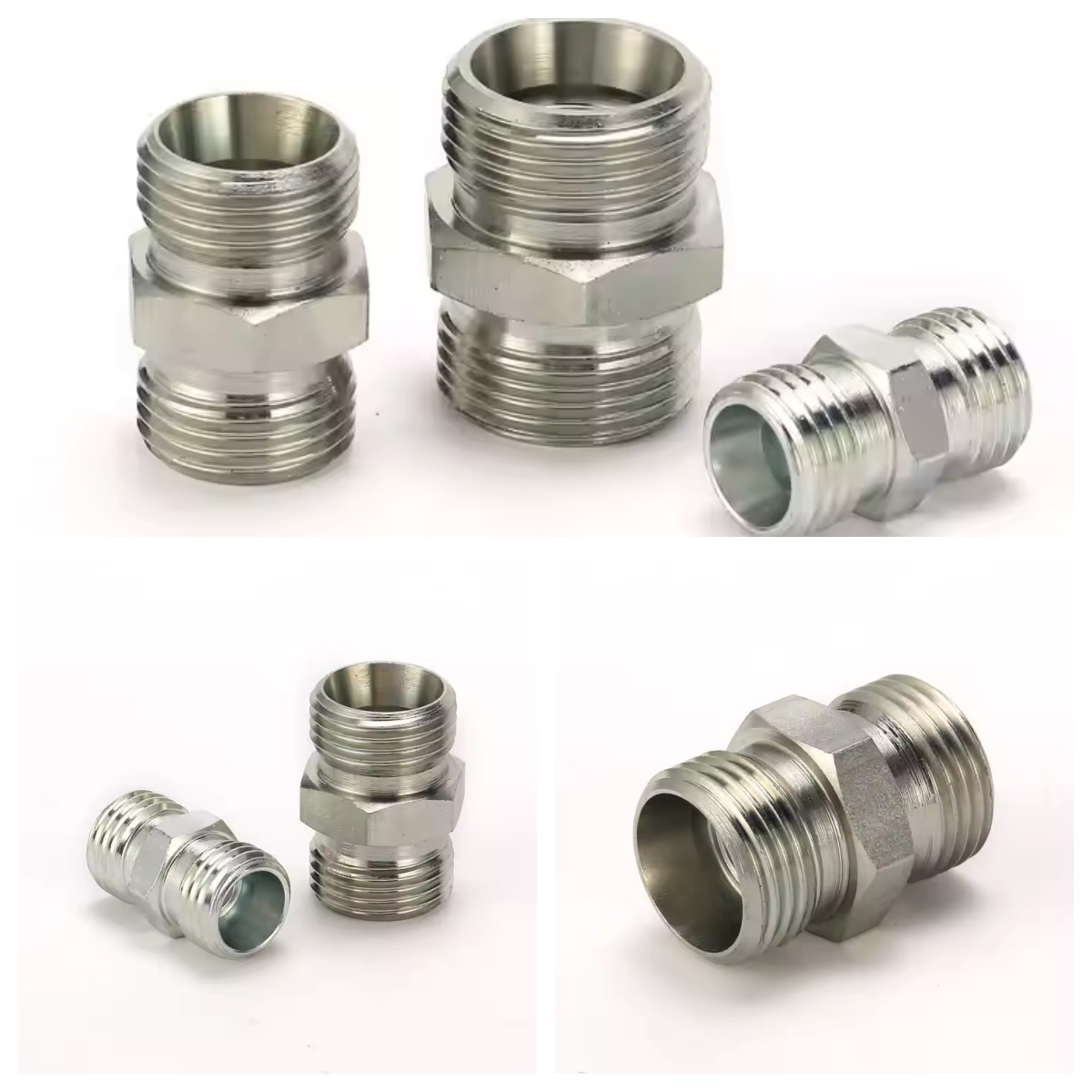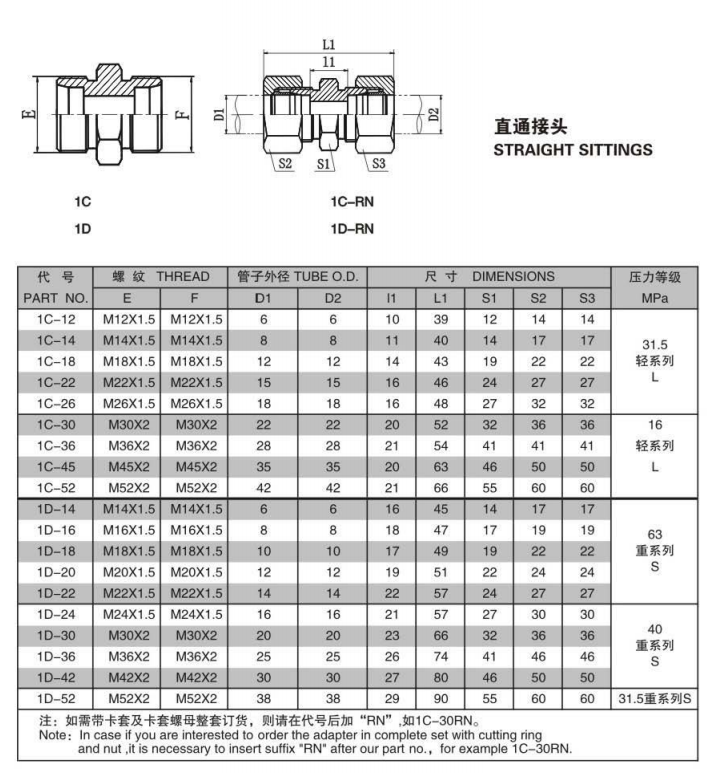Product Description

Durable Metals
For applications where high strength and resistance to pressure are required, 1C and 1D straight reducers are often crafted from metals such as stainless steel, brass, or carbon steel. Stainless steel variants, especially those with a high chromium and nickel content, offer excellent corrosion resistance. This makes them suitable for use in harsh environments, such as in chemical processing plants where the fittings may be exposed to corrosive fluids. Brass, on the other hand, is known for its good machinability and resistance to dezincification, making it a popular choice for plumbing applications. Carbon steel reducers provide high strength and are cost - effective for general - purpose industrial uses, although they may require additional coatings or treatments to prevent rusting in certain environments.
High - Performance Plastics
In situations where lightweight materials, chemical resistance, or electrical insulation are important, these reducers can be made from high - performance plastics. Materials like polyvinyl chloride (PVC), chlorinated polyvinyl chloride (CPVC), and polypropylene (PP) are commonly used. PVC reducers are widely used in plumbing systems for their affordability, corrosion resistance, and ease of installation. CPVC offers enhanced heat resistance compared to PVC, making it suitable for hot water applications. Polypropylene reducers are known for their excellent chemical resistance and are often used in chemical processing and food - grade applications.
Straight - Through Design
The straight - through design of the 1C and 1D reducers is a key feature that sets them apart. This design allows for a streamlined flow of fluids, minimizing turbulence and pressure drops within the system. By maintaining a straight path for the fluid, these reducers ensure efficient transfer of liquids or gases, which is crucial for optimizing the performance of pumps, compressors, and other equipment in the system. The smooth interior surface of the reducers further contributes to reducing friction, enhancing the overall flow characteristics.
Precise Diameter Transitions
These reducers are engineered to provide a precise transition between different - sized pipes. The larger end of the reducer is designed to fit snugly with the larger - diameter pipe or hose, while the smaller end is tailored to connect with the smaller - diameter component. The transition in diameter is carefully calculated and manufactured to ensure a secure and leak - free connection. This precision in design not only prevents leaks but also helps in maintaining the proper flow rate and pressure within the system.
Specification
| Material: | Stainless steel、Carbon Steel、copper |
| Size: | All size |
| Weight: | *g |
| MOQ: | 100pcs |
| Packing: | Carton case |
| Color: | silver |

Advantage
Convenient Installation
Simple Operation: During installation, you just need to insert the pipe into the ferrule fitting and tighten the nut with a wrench. There is no need for complex operations such as welding or flaring, which can save a great deal of installation time and labor costs.
No Special Tools Required: Generally, only commonly used tools like wrenches are needed to complete the installation. Unlike some other fittings that require specialized welding equipment or flaring tools, this reduces the installation threshold and equipment requirements.
Reliable Connection
Good Sealing Performance: When the nut is tightened, the ferrule will deform and firmly grip the pipe, forming multiple sealing barriers. This can effectively prevent the leakage of hydraulic oil and ensure the sealing and stability of the hydraulic system.
Strong Vibration Resistance: During the operation of the hydraulic system, even in the presence of vibrations and impacts, the clamping force between the ferrule and the pipe can ensure that the connection will not loosen, maintaining the normal operation of the system.
High Compatibility
Suitable for Multiple Pipe Materials: It can be connected to pipes made of various materials such as steel pipes, copper pipes, and stainless - steel pipes, meeting the requirements of different hydraulic systems for pipe materials with a wide range of applications.
Multiple Pressure Ratings Available: There are products of different specifications and pressure ratings for selection. They can adapt to various hydraulic systems ranging from low pressure to high pressure, meeting the usage requirements under different working conditions.
Convenient Maintenance
Easy Disassembly: When it is necessary to repair or replace components, simply loosen the nut, and the ferrule fitting can be removed from the pipe without causing damage to either the pipe or the fitting, which facilitates subsequent repair and replacement work.
Reusable: After the ferrule fitting is disassembled, if components such as the ferrule and nut are not damaged, they can be used again, reducing the maintenance cost.
Tidy Appearance
Aesthetically Pleasing After Installation: Compared with connection methods such as welding, the ferrule fitting presents a neater and more aesthetically pleasing appearance after installation. There will be no traces like welding scars left behind, making the overall layout of the hydraulic system more regular.
Application
The hydraulic ferrule fitting is a commonly used connecting component in hydraulic systems and has a wide range of applications, mainly reflected in the following fields:
Industrial Machinery
Machine Tool Equipment: It is used to connect the hydraulic pipelines of machine tools, such as the connections between hydraulic pumps, hydraulic cylinders and control valves, ensuring the smooth transmission of hydraulic oil and achieving precise control of actions such as the feed of the machine tool worktable and the clamping of the cutting tool.
Injection Molding Machines: In the hydraulic system of injection molding machines, it connects various hydraulic components. For example, it conveys the high-pressure oil output by the oil pump to the mold clamping cylinders, injection cylinders, etc., ensuring the stable execution of process actions such as mold clamping, injection, and pressure holding of the injection molding machine.
Construction Machinery
Excavators: Applied in the hydraulic system of excavators, it connects the hydraulic oil pipes, supplies pressure oil to the hydraulic cylinders of working devices such as the digging arm and the bucket, enabling operations like digging and loading/unloading. It is also used to connect the hydraulic motors to drive the traveling mechanism and the slewing mechanism.
Cranes: In the hydraulic systems for hoisting, luffing, slewing, etc. of cranes, the hydraulic ferrule fittings connect various hydraulic components into a complete system, allowing the crane to safely and efficiently complete the tasks of lifting and handling heavy objects.
Automobile Manufacturing and Maintenance
Automobile Production: In the hydraulic equipment on the automobile production line, such as the stamping machines for automobile parts and hydraulic fixtures, the hydraulic ferrule fittings are used to connect the hydraulic pipelines, ensuring the normal operation of the equipment and improving production efficiency and product quality.
Automobile Maintenance: During the process of automobile maintenance, it is used to connect the maintenance equipment with the hydraulic system of the automobile. For example, when repairing the automobile braking system, it connects the brake fluid filling equipment with the automobile braking pipeline, ensuring the smooth progress of the maintenance and debugging work of the braking system.
Metallurgical Industry
Steel Rolling Equipment: In the hydraulic screw-down system and hydraulic roll bending system of steel rolling mills, hydraulic ferrule fittings connect the hydraulic pipelines, providing reliable hydraulic connections for the adjustment of the position of the rolls, the control of the rolling force, etc., ensuring the rolling accuracy and quality of steel products.
Smelting Equipment: It is used to connect the hydraulic pipelines of the hydraulic tilting devices of smelting furnaces, hydraulic clay guns and other equipment, ensuring that these devices can operate stably in a high-temperature and harsh working environment and complete operations such as furnace tilting and tapping hole blocking.
Shipbuilding Industry
Ship Power System: In the main engine starting system and steering gear hydraulic system of ships, hydraulic ferrule fittings are used to connect the hydraulic pipelines, providing reliable hydraulic connections for the power transmission and direction control of ships, ensuring the safe navigation of ships.
Ship Loading and Unloading Equipment: In the hydraulic systems of ship loading and unloading equipment such as ship cranes and winches, hydraulic ferrule fittings connect various hydraulic components, enabling various actions of the loading and unloading equipment and improving the loading and unloading efficiency of ships.